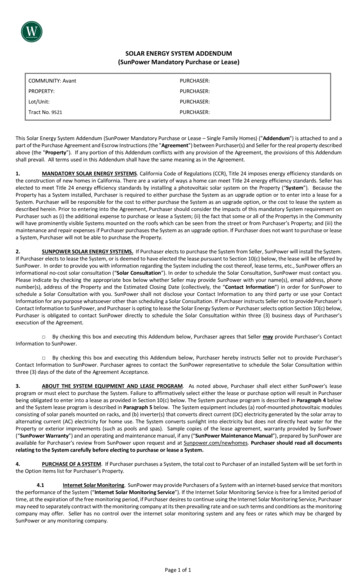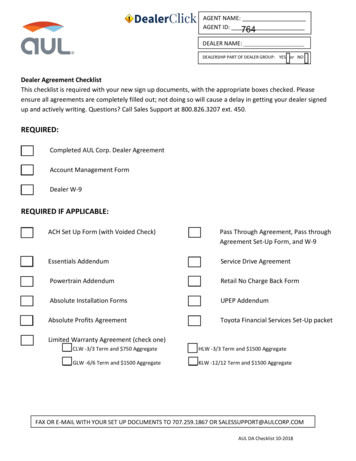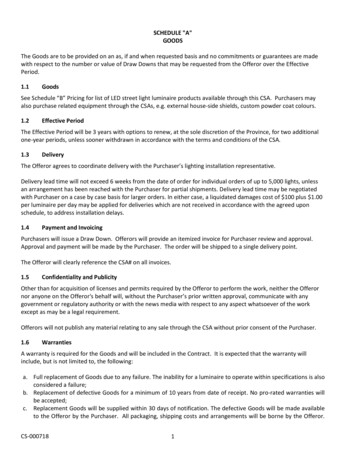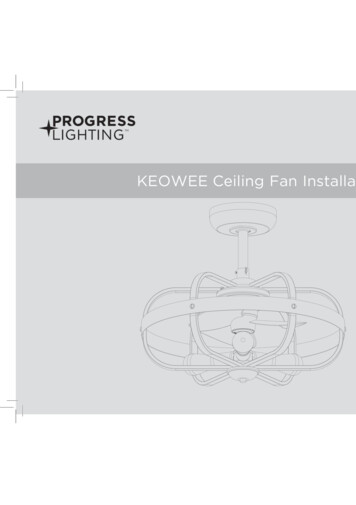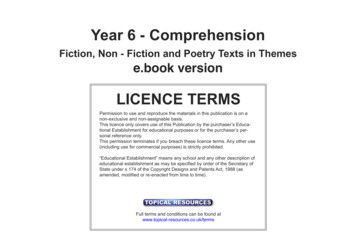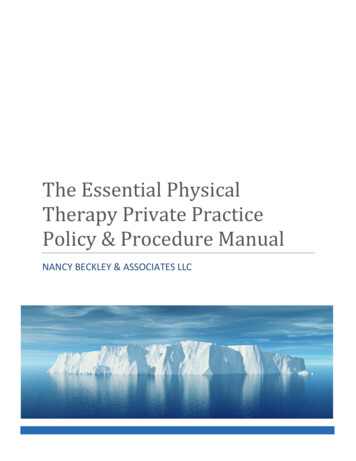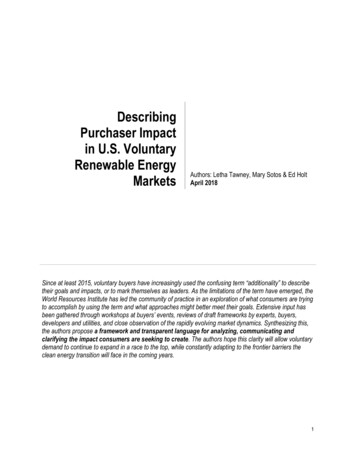
Transcription
DescribingPurchaser Impactin U.S. VoluntaryRenewable EnergyMarketsAuthors: Letha Tawney, Mary Sotos & Ed HoltApril 2018Since at least 2015, voluntary buyers have increasingly used the confusing term “additionality” to describetheir goals and impacts, or to mark themselves as leaders. As the limitations of the term have emerged, theWorld Resources Institute has led the community of practice in an exploration of what consumers are tryingto accomplish by using the term and what approaches might better meet their goals. Extensive input hasbeen gathered through workshops at buyers’ events, reviews of draft frameworks by experts, buyers,developers and utilities, and close observation of the rapidly evolving market dynamics. Synthesizing this,the authors propose a framework and transparent language for analyzing, communicating andclarifying the impact consumers are seeking to create. The authors hope this clarity will allow voluntarydemand to continue to expand in a race to the top, while constantly adapting to the frontier barriers theclean energy transition will face in the coming years.1
Executive SummaryAt 62 percent of U.S. retail electric sales, commercial and industrial electricity consumers can substantiallyinfluence the demand for renewable energy and accelerate the pace of electric sector decarbonization.Businesses and other large-scale energy consumers are increasingly setting greenhouse gas (GHG)emission reduction targets and/or renewable energy goals, so more companies are seeking ways tocredibly talk about their actions and impacts, and to distinguish their impacts from others.In its simplest form, buying and using renewable energy demonstrates leadership, particularly because thatchoice is still relatively rare. The multitude of ways that consumers buy and use it can have very differentimpacts on the electricity grid. Impact is not limited to big companies; small and mid-sized companies withstrong local ties can also be profoundly influential regionally. Consumers seeking to be identified as leaderswant to have a material impact on creating clean, renewable energy without overstating their claims.Consumers frequently emphasize the “additionality” of their actions, or how important “additionality” is. Thisconcept originated in GHG project accounting with specific tests, and doesn’t effectively translate tocorporate GHG accounting. Corporate GHG accounting claims the use of renewable electricity and otherenergy sources, and the associated GHG emissions. In contrast, GHG project accounting claims additionalgeneration has been created and caused by actions reliant on the offset revenue. Additionality is morecomplicated than just new capacity. Casual claims of “additionality” are potentially misleading and shouldbe avoided.To credibly and effectively articulate the consumer’s role in positive outcomes, we propose a simpledescriptive framework to complement well-defined renewable electricity and GHG reporting standards. Thisoffers companies transparent, supplemental language to describe the impact that they are having in termsof energy and GHG reductions. It highlights the environmental benefits of purchases, as well as theattribution of corporate influence in making positive impacts happen. The two key elements are:1. What you did – Transparently communicating what the purchase is; its scale, scope and term; how itgoes beyond regulatory requirements; its impact on new or existing generation; and GHG emissions.2. How you did it – Clearly describing your role in the outcome; financial and risk positions in any projector purchase; role in influencing policy changes; increasing access for other consumers; or otheraspects of participation in the renewable energy market transformation.Consumers should think of their impact in terms of how their efforts lead to transformation of the electricsector. Large and direct voluntary purchasing can have big, immediate impacts on production. But smallerprocurements with indirect impacts can send important demand signals. Both are needed to reduce GHGemissions and influence investment in new generation development. Different procurement paths areappropriate for different companies under different circumstances. What constitutes leadership and impactmay also change as markets mature, public policy evolves, market awareness and acceptance grows,individual consumer experience increases and economic feasibility improves.Demonstrating impact toward reducing GHG emissions in the electric sector is a race to the top, alwaysseeking to use the consumer’s leverage to maximize the positive impact of purchases and buying power.No one purchasing option will always serve that ever-moving frontier, but transparent communicationsabout impact will fuel the desired change.2
I. IntroductionSpurred by declining technology costs and public policies at all levels of government, the United States isgradually making the transition to a cleaner electricity supply. Non-hydro renewables accounted for 8.8percent of 2016 net electricity generation in the United States.1 Although it is a solid increase (up from 4.7percent in 2011 and 2.4 percent in 2006), there is still a long way to go if the United States is going tosignificantly reduce greenhouse gas (GHG) emissions.Thousand MWhFigure 1. Renewable Source Contribution to Net Generation — United 00000100000050000002001All net generation1.9%2.4%4.7%8.8%200620112016RE including conventional hydroNon-hydro renewablesSource: U.S. Energy Information Administration, Electricity Data Browser, 2018.Commercial and industrial electricity users (C&I consumers) represent 62 percent of U.S. retail electricitysales.2 With this procurement power, they can substantially influence the demand for renewable energy,transform the electricity supply mix and accelerate the scale and pace of electric sector decarbonization.In the United States, voluntary demand for renewable electricity is growing at a rate of nearly 20 percentper year,3 and is being driven by non-residential consumers.4 Motivated by sustainability and financialgoals, many consumers are striving to increase their purchase of renewable energy, lower their GHGemissions and ensure predictable and stable electricity prices.1U.S. Energy Information Administration, Electricity Data Browser. ssed Feb. 22, 2018.2 Ibid.3 O’Shaughnessy, E., J. Heeter, J. Cook and C. Volpi. 2017. Status and trends in the U.S. voluntary green powermarket (2016 data). National Renewable Energy Laboratory. Retrieved fromhttps://www.nrel.gov/docs/fy18osti/70174.pdf.4 O’Shaughnessy, E., C. Liu and J. Heeter. 2016. Status and trends in the U.S. voluntary green power market (2015data). National Renewable Energy Laboratory. Retrieved from https://www.nrel.gov/docs/fy17osti/67147.pdf.3
Textbox 1.There are a range of commitment platforms and peer networks for large-scale energy consumers. Over 120 of the world’s most influential companies have joined RE100, an initiative workingto increase demand for renewable energy by committing to purchase 100% renewableelectricity.Science Based Targets is an initiative through which over 320 leading businesses setgreenhouse gas emission reduction targets in line with climate science.Over 325 U.S. cities have made a commitment to climate action.More than 600 colleges and universities have committed to take action on climate as part ofthe President’s Climate Leadership Commitments, supported by Second Nature.EPA’s Green Power Partnership has helped establish minimum usage benchmarks for a widerange of non-residential consumers and recognizes leadership in renewable electricity useacross a wide range of credible supply options.The Renewable Energy Buyers Alliance (REBA) supports large-scale consumer demand forrenewable power by helping utilities and others effectively meet it.The renewable energy purchasing actions consumers take are varied, fulfilling different business needsand creating different systemic impacts. Some purchases are short-term while others are long-term, somesupport existing renewable projects while others support projects still in development, and some renewableenergy is purchased from another party while others are developed and owned by the consumer.Different purchases have different impacts in different markets. All renewable energy purchases contributeto overall demand growth, but bigger purchases usually have more impact than small ones. Somepurchases have indirect impacts, as aggregate rising demand (voluntary as well as mandatory demand)leads to increasing supply. Some actions include a more direct engagement with the renewable energyproject(s) that supply the consumer. Some actions have impacts beyond immediate supply and demand byinducing changes in public policy or regulations, or in the consumer’s own supply chain.With this range of potential actions and impacts, consumers want to know: What is leadership? How canthey talk credibly about their actions and the positive impact they are having?This paper seeks to answer these questions so that electricity market transformation can be acceleratedthrough the varied actions of consumers – recognizing that regional electricity systems are at differentstages of transformation – and consumers can claim their impact credibly. This paper proposes aframework for transparently articulating the consumer’s role in positive outcomes.Section II provides background on energy usage claims, fundamental consumer motivations for usingrenewable electricity and the growing consumer movement. Section III contrasts usage claims with claimsof additionality. Section IV distinguishes leadership from impact, and describes how impact may be createdthrough both procurement and non-procurement actions. Section V proposes a template for howorganizations communicate about their actions and their impacts. Section VI concludes with hypotheticalexamples, putting these recommendations into practice.4
II. BackgroundAs more and more consumers choose renewable electricity, they report their activities to their stakeholdersin press releases, marketing materials, sustainability reports and GHG registries. There are a variety ofsources advising them about how to talk about their actions in ways that are clear, factual and credible. In2016, RE100 issued a technical brief summarizing useful guidance on electricity usage claims.5According to the RE100 guidance, credible renewable electricity usage claims and the criteria forcontractual allocation of attributes (including energy attribute certificates) require:1. Credible generation data;2. Attribute aggregation;3. Exclusive ownership of attributes (no double counting);4. Exclusive claims on attributes (no double claiming);5. Geographic market limitations of claims; and6. Vintage limitations of claims.In other words, to make a renewable electricity claim, the consumer must be able to support the claimthrough ownership of the attributes, ideally in the form of cancelled or retired energy attribute certificates,such as a renewable energy certificate (REC) in the United States or Guarantees of Origin (GOs) in theEuropean Union. This is a fundamental condition of renewable electricity use. Certificates are anaccounting instrument that must be acquired regardless of how renewable electricity is purchased.Corporate GHG accounting of emissions from electricity use (scope 2 carbon footprint claims) also requireenergy attribute certificates or other contractual instruments that convey the emission rate attribute for therenewable generation facility.6 Again, certificates are used as an emissions accounting tool, and allrenewable energy certificates are equal with a zero-emission rate (setting aside the situation where somebiomass combustion and other renewable resources may have non-zero emissions). Regardless of howthey are acquired – through long-term contracts or year-to-year purchases of renewable electricity – allcertificates are equal in the eyes of GHG accounting. It is not the role of GHG accounting to demonstraterelative levels of impact by different consumers.Therein lies a challenge for consumers that want to express impact beyond making a credible renewableenergy consumption and scope 2 emissions claims. If all renewable electricity is the same from anaccounting perspective, how else can an organization distinguish itself?5Braslawsky, J., T. Jones and M. Sotos. 2016. Making credible renewable electricity usage claims. RE100 Technicaladvisory group briefing. Retrieved from RE100CREDIBLECLAIMS.pdf.6Sotos, M. 2015. GHG Protocol Scope 2 Guidance: An Amendment to the GHG Protocol Corporate Standard. WorldResources Institute and World Business Council for Sustainable Development. Retrieved fromhttp://www.ghgprotocol.org/scope 2 guidance.5
Making A DifferenceAlthough energy attribute certificates are all the same from an accounting standpoint, regardless of howthey are acquired, consumers taking voluntary action to support renewable electricity want to make adifference. Making a difference can mean different things and take different forms, but fundamentally,consumers want to have a material impact on moving the electric sector toward more clean, renewableenergy.This is already happening in a big way: The U.S. Environmental Protection Agency’s (EPA) Green Power Partnership boasts over 1,300partner organizations that meet program criteria. Leading the pack is Microsoft (purchasing4,557,278 MWh) and Intel (purchasing 4,152,035 MWh). It’s no accident that the leaders both represent tech firms, given their growing energy needs topower expanding data use. The National Renewable Energy Laboratory (NREL) reports that thetech sector leads the market for power purchase agreements (PPAs), with Google, Amazon, Appleand Microsoft in the top five signing for the most PPA capacity.7 Corporations are beginning to make an impact on the installation of new utility-scale photovoltaic(PV) capacity, accounting for 9 percent of annual installed capacity in 2016 and 17 percent by early2017. According to NREL, “through July 2017, corporate consumers contracted for more than2,300 MW of utility-scale solar, primarily using financial PPAs and green tariff or bilateral contractswith utilities.”8In addition to the tech firms, retailers Kohl’s, Starbucks, IKEA, Walmart and H&M are top-rated in theUnited States by the Green Power Partnership. Even organizations that are not in obviously competitivefields, such as hospitals, colleges or non-profit organizations – including governmental entities – attractsupport from stakeholders by demonstrating leadership in purchasing renewable electricity.Collectively and individually, these actions are making a difference and many consumers have good storiesto tell. Their stories may be about engaging directly with project developers and helping to bring newcapacity online; buying renewable electricity for 100 percent of the organization’s needs through unbundledREC procurements; being first among their peers to take an action; leading others to take group action, asin a multi-party PPA or a shared renewables community project; taking a risk in demonstrating a newtechnology; and influencing their supply chain.Simply using renewable electricity demonstrates leadership given the substantial number of consumers thatdo not yet choose it. However, the multitude of ways that consumers go about procuring and using it canhave very different impacts on transforming the electricity grid. The more commonplace renewableelectricity use becomes, the more important it is to consumers to distinguish their impact from anotherconsumer's impact.O’Shaughnessy, E., J. Heeter, J. Cook and C. Volpi. 2017. Status and Trends in the U.S. Voluntary Green PowerMarket (2016 Data). National Renewable Energy Laboratory. Retrieved fromhttps://www.nrel.gov/docs/fy18osti/70174.pdf.8 Heeter, J., J. Cook and L. Bird. 2017. Charting the Emergence of Corporate Procurement of Utility-Scale PV.National Renewable Energy Laboratory. Retrieved from https://www.nrel.gov/docs/fy17osti/69080.pdf.76
As they talk about their actions, many consumers emphasize that their purchase results in the developmentof additional or incremental renewable energy capacity. Some even use the term “additionality” as a nounto represent the impact of their purchase – as a proxy term for impact. Often consumers introduce this ideaof causation into statements of emissions reductions. Using additionality as a term of impact can createconfusion with project carbon accounting and carbon offset instruments (which are different from RECs)that have formalized definitions of “additionality.”9 This confusion, in turn, raises credibility issues forconsumer claims.III. The Burden of AdditionalityAdditionality was the buzzword at the 2017 REBA Summit.10 Companies describing their renewableelectricity purchases frequently emphasized the additionality of their actions, or how important additionalityis to making a difference. But what is additionality and what makes a purchase additional?When used to describe renewable energy purchases and investments, “additional” and “additionality” areimprecise terms, subject to different definitions and interpretations. These terms appear in several recentreports11 where they typically mean that the renewable electricity purchase is: Driving additional renewable investment or capacity.Using high-impact procurement methods.Supporting new or additional projects compared to what might have occurred.The concept of additionality originated in GHG project accounting. To claim emission reductions (a carbonoffset) for a renewable energy or other kind of project, the emission reductions must be quantified relativeto baseline emissions, sometimes referred to as business-as-usual (BAU). Comparing project emissions toBAU is important because the purpose of project accounting is to determine an absolute reduction in globalemissions, and this requires a comparison to a baseline – even if it is hypothetical – to quantify theadditional renewable generation.9U.S. Environmental Protection Agency, Green Power Partnership, 2018. Carbon Footprint Reduction Instruments.Retrieved from duction-instruments.10 REBA is the Renewable Energy Buyers Alliance, whose purpose is to help companies understand the benefits ofmoving to renewables, connect large buyer demand to renewable energy supply, and help utilities better understandand serve the needs of all energy buyers. REBA is led by four non-profit organizations: BSR’s Future of InternetPower, RMI’s Business Renewables Center, WRI’s Electricity Initiative and WWF and WRI’s Renewable EnergyBuyers’ Principles. See http://www.rebuyers.org.11 Examples:Cook, G., J. Lee, T. Tsai, A. Kong, J. Deans, B. Johnson and E. Jardim. 2017. Clicking Clean:Who Is Winning the Race to Build a Green Internet? Greenpeace. Retrieved from http://www.clickclean.org/usa/en/.Meister Consultants Group. 2016. Opportunities to Increase Corporate Access to Advanced Energy: A National Brief.Advanced Energy Economy Institute. Retrieved from .pdf?t 1470801137966.GreenBiz. 2017. State of Corporate RE Procurement. Apex Clean Energy. Retrieved ations-want-clean-energy/.7
Establishing the baseline is an art by itself. There are two methods used to estimate baseline emissions,but the one that is most relevant to project accounting requires “an estimate of baseline emissions throughthe identification of a baseline scenario specific to the proposed project activity. The baseline scenario isidentified through a structured analysis of the project activity and its alternatives. Baseline emissions arederived from the baseline scenario and are valid only for the project activity being examined.”12The baseline is a counterfactual scenario – what would have happened absent the project. It is not astatement of historical emissions. Many projects reduce GHG emissions relative to historical levels, butwould have happened regardless of GHG motivations.Distinguishing project emissions from the baseline emissions is referred to as determining additionality.Because the baseline scenario is hypothetical and uncertain, some contend that this estimationmethodology should be accompanied by explicit additionality tests.There are a number of such tests – though there is confusion because terminology is not consistent andsome definitions overlap13 – but the consumer information presented by Carbon Offset Research andEducation offers a short selection of additionality tests that are commonly used:14 Legal and Regulatory Additionality Test: In the context of renewable energy markets, the GHGproject must reduce GHG emissions below the level required by policy mandate, e.g. a renewablesobligation or renewable portfolio standard. This test is already in the canon of voluntary renewableenergy markets.15Financial Test: The GHG project activity must be economically or financially infeasible orunattractive without carbon revenue. Where multiple sources of revenue are possible, how doesone prove that the carbon revenue is the decisive reason that makes the project economicallyfeasible?16 This is hard to prove without project developers opening their books for examination.17Barriers Test: Regardless of profitability, the GHG project faces non-financial barriers (e.g.technology-related, institutional, organizational, cultural or social barriers) that prevent itsimplementation, and that the business-as-usual alternative would not have to face. The project,with the purchaser’s help, succeeds in overcoming these barriers.Common Practice Test: A project can only be considered additional if it employs technologies orpractices that are not already in common use.1812GHG Protocol. 2005. The GHG Protocol for Project Accounting. World Resources Institute and World BusinessCouncil for Sustainable Development (p. 13). Retrieved p/standards/ghg project accounting.pdf.13 Gillenwater, M. 2012. What is Additionality? Part 1: A long standing problem. GHG Management Institute,Discussion Paper No. 001 Version 03. Retrieved from AdditionalityPaper Part-1ver3FINAL.pdf.14 Carbon Offset Research and Education is sponsored by the Stockholm Environment Institute and the GHGManagement Institute. See ality.html.15 In the United States where a single type of energy attribute instrument (a REC) is used, it is easy to demonstratethat renewable energy purchasing is above and beyond what is otherwise required by law. By owning the instrument,a voluntary consumer thus denies its use by a regulated entity, and in doing so, the renewable energy represented bythe instrument is said to be additional or surplus to regulation.16 Some would argue that any project that receives a financial incentive would not meet a strict additionality test. Thispresents a problem in many markets where government intervention through incentives is commonplace.17 Often contractual non-disclosure agreements prevent transparency of financial and other competitive information.18 The U.S. EPA and other voluntary market supporters espouse the Common Practice test and the RegulatoryAdditionality test together as the most realistic additionality tests to assess.8
Additionality is critical to the success and integrity of GHG programs that recognize project-based GHGreductions – for example, in the carbon offset market. But most renewable electricity purchasers are notpursuing project accounting for carbon offsets.19 Instead, most organizations buying renewable electricityare interested in corporate accounting – aninventory of their organization’s emissionresponsibilities – and corporate accountingCorporate accounting is a claim of renewablefollows different rules because it is countingelectricity use, while project accounting is a claim ofsomething different. Corporate accounting isadditional generation beyond a baseline.about claiming the use of renewable electricity,alongside the use of other energy sources andtheir resulting GHG emissions.With a focus on current emissions resulting from an organization’s activities, corporate accounting is notconcerned with why a reporting organization was able to reduce emissions from one inventory to the next.Instead, the focus is on providing a replicable management tool for credibly and comparably documentinginventory snapshots from one reporting period to another.It is also said that additionality is about assessing causation,20 but even if the consumer’s interventioncaused the project to be built, causation alone is not sufficient to meet the additionality tests. Manyrenewable generating projects caused by developers or by contracting buyers are not additional toregulation, are financially feasible without a carbon revenue or market, face the same barriers as othersimilar projects, and/or do not employ uncommon technologies. In other words, additionality is a lot morecomplicated than just adding new capacity.Given the uncertainty around baselines and theConsumers should limit claims about additionality unless fact that additionality requires proof, not just acasual claim that a purchase is additional, thethey are qualifying a renewable electricity project forterm additionality is best avoided in the contextcarbon offsets.of voluntary purchasing and consumption ofrenewable electricity. Just as the U.S. FederalTrade Commission (FTC) has advised against using the term “green” in renewable energy marketing,recommending instead that organizations make straightforward statements of the facts, consumers shouldleave additionality to project accounting where it has a formal role. They should instead focus on describingtheir leadership in using renewable electricity and distinguishing the impacts of their purchases instraightforward language.21 This approach lets the audience make its own judgment as to whether theaction is green enough – or in this case, additional enough.19Some possible reasons for this are that (1) consumers may recognize that their project is not additional so theydon’t follow that path; (2) third-party project owners may be unwilling to give up the direct emissions reduction to theconsumer (or there may be no contractual arrangement that would support such a transfer); (3) documentation forverifying and obtaining a project offset may cost too much; (4) the increasing prospect of carbon regulation in the U.S.electricity market would undermine the value of project offset investments; and (5) formal or informal market rulesmay prohibit project owners from seeking both offsets and energy attribute certificates.20 Gillenwater, op. cit.21 For another perspective on additionality, see Center for Resource Solutions. 2016. Additionality and RenewableEnergy Certificates: Understanding the value of REC claims. Retrieved from 16/03/RECs-and-Additionality.pdf.9
IV. Understanding Leadership and ImpactIn the United States, voluntary sales of renewable electricity to final consumers in 2016 were an estimated95,450,000 MWh.22 Despite the positive growth cited above, this still amounts to just 2.5 percent of totalretail electricity sales in the U.S. The figure includes residential as well as non-residential renewableelectricity purchasing, so the number of organizations that are doing the buying and getting the credit isactually very small. This is not to dismiss voluntary action as ineffectual, but rather to emphasize thatrenewable energy purchasing through any means is still the exception rather than the rule.Leadership is taking an action that influences others within a common sphere of influence to aspire to andfollow. In the context of supporting renewable energy, leadership is the voluntary choice of renewable overconventional sources of electricity and by so doing, contributing to the transformation of the electricitymarket to cleaner sources of energy. In itssimplest form, buying and using renewableLeadership is the voluntary choice of renewable overenergy, particularly when it is an otherwiseconventional sources of electricity, plain and simple.uncommon practice, is leadership when thataction inspires others.With this definition, everyone who uses renewable electricity is a leader within their own sphere ofinfluence. Whether a consumer buys unbundled RECs or builds a utility-scale solar project, they aredemonstrating leadership by setting a direction for others to follow.There is a tendency to describe leadership in terms of impact, or to talk about leadership and impact asthough they are interchangeable. While linked, leadership and impact are different things. The use ofrenewable electricity demonstrates leadership, but the multitude of ways that consumers buy and use ithave very different impacts on transforming theelectricity grid.Impact is the relative effect, direct and indirect, of anaction on transforming the electric grid.Distinct from leadership, impact is the relativeeffect or influence of an action that someone orsomething, especially something new, has onothers or on a situation (e.g. the electric grid), and may take into account both tangible and intangible, ordirect and indirect consequences of that action.Impact can be demonstrated and described in numerous ways. In the context of renewable electricitypurchasing, impacts could emerge through investing in new projects; demonstrating a new purchasing,legal or financing model; direct project contracting; purchasing 100 percent renewables; being the first in asector to demonstrate the business case for renewable electricity; being a large-s
To credibly and effectively articulate the consumer's role in positive outcomes, we propose a simple descriptive framework to complement well-defined renewable electricity and GHG reporting standards. This offers companies transparent, supplemental language to describe the impact that they are having in terms of energy and GHG reductions.
